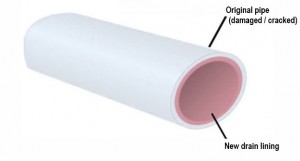Drain Relining – The Basics
February 3, 2014 Signs of damage to our drains and pipework are not always obvious. Bad smells and standing water might indicate a blockage, but any damage to the interior walls of our drains is not very easy to detect and might lead to serious issues further down the line.
Signs of damage to our drains and pipework are not always obvious. Bad smells and standing water might indicate a blockage, but any damage to the interior walls of our drains is not very easy to detect and might lead to serious issues further down the line.
The Advantages of Drain Lining
Perhaps the most straightforward way to ensure that your drains are in the best shape possible is to carry out drain relining. This technique has many advantages, and is a non-destructive way to secure your pipes as no digging or extraction is required – especially advantageous on commercial properties, where no downtime is enforced and business can continue as normal.
Initial Inspection
 Essentially, relining fits a protective layer to the inside of your drains, forming a reinforced coating that protects against cracks and other damage. The process should begin with a thorough inspection of the drains, preferably using CCTV survey technology, to determine the location and extent of any damage, before the pipes are fully flushed out using high powered water jetting. This stage is important, as it is crucial for the internal wall of the drains to have a clean and even surface for the lining to attach itself to. It is also a good idea to continue to monitor the drains with CCTV throughout the relining process to ensure that everything is running as it should.
Essentially, relining fits a protective layer to the inside of your drains, forming a reinforced coating that protects against cracks and other damage. The process should begin with a thorough inspection of the drains, preferably using CCTV survey technology, to determine the location and extent of any damage, before the pipes are fully flushed out using high powered water jetting. This stage is important, as it is crucial for the internal wall of the drains to have a clean and even surface for the lining to attach itself to. It is also a good idea to continue to monitor the drains with CCTV throughout the relining process to ensure that everything is running as it should.
Installation
Installation can then begin by threading the lining, usually made from flexible resin, through the pipework either using an inflated air bag to shape the lining to the internal walls, winched in, or forced into place using water pressure (a method known as ‘inversion’). After it is installed, the resin is then cured (hardened) using either hot water or UV lighting to form an inner pipe. The lining is not only designed to protect and repair, it also aids water flow with a low friction surface.
The non-destructive nature of drain relining not only means the process is quick and easy, but is also extremely cost-effective. The lining is robust enough to last years without further attention, and can be fitted to pipes of all sizes, from as small as 50mm diameter to over a metre. Depending on the demands of the environment or accessibility of the drains, relining can be carried out using one long lining, or several smaller sheets overlapping one another throughout the pipework.
Patch relining is also available, proving an even cheaper method of repairing one specific area of a pipe that has become damaged.
Before & After Comparison
—
Here at Express Drainage Solutions, our expert team are on hand throughout London and the surrounding areas to provide detailed and free CCTV inspections as well as drain relining where necessary. Depending on the extent of the damage and size of the drains, relining can be completed in only a couple of hours, saving you time, money and hassle.
With many years of experience in the industry, and accreditation from The Guild of Master Craftsmen and the Contractors Health and Safety Assessment Scheme (CHAS), you can rely on Express Drainage Solutions to deliver the highest quality every time. Get in touch today to find out more.
This entry was posted in Drainage. Bookmark the permalink. ← Flushable Items: Are They Really Safe?